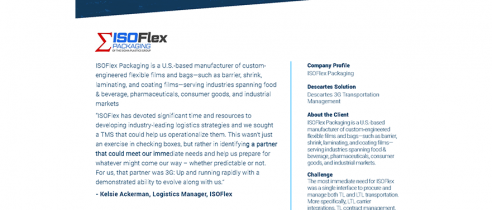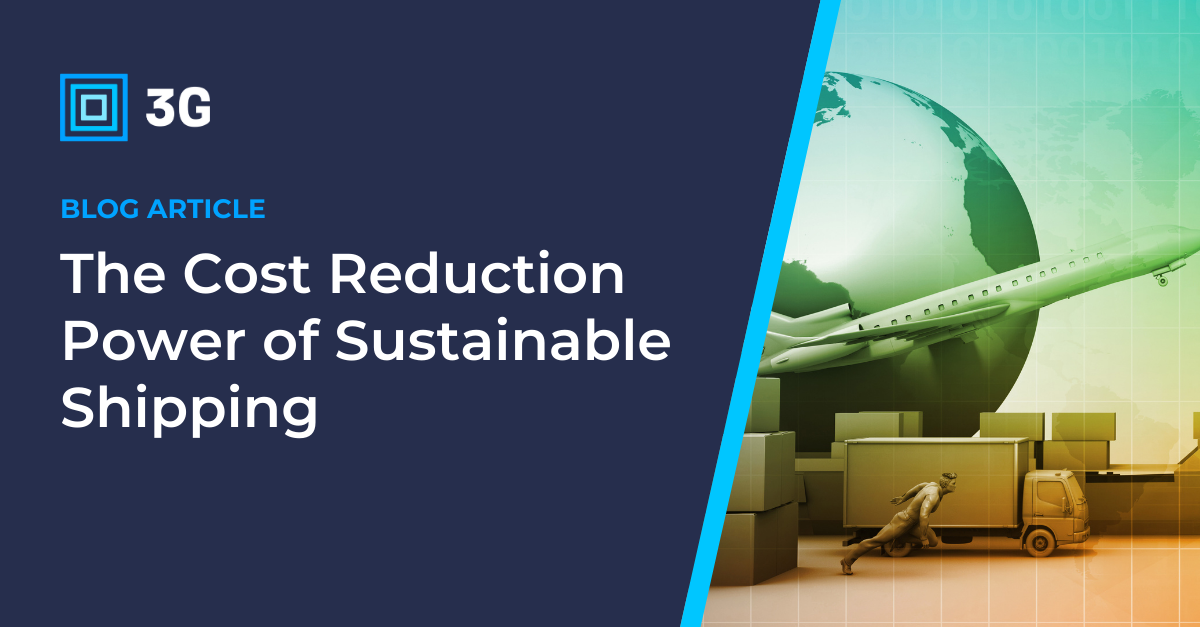Both across the globe and domestically, governments are introducing an increasing number of regulations aimed squarely at achieving zero emissions shipping, with mandates like industry-wide carbon emission targets and requirements for more sustainable shipping technology. Stakeholders throughout the supply chain are making operational adjustments to adapt, raising concerns about complexity and potential for compliance-related financial burdens.
Shippers are now faced with the dual challenge of redesigning their operations to meet these stricter sustainable logistics standards while managing the high costs associated with such transformative efforts. But though it’s easy to focus solely on the cost of reducing carbon emissions, at 3G, we’re increasingly realizing that optimized shipping is sustainable shipping — a way to not only dramatically reduce operating costs, but also protect the environment.
The Cost of Achieving Sustainable Shipping
Fortunately, initial compliance with many of these new transportation emissions regulations in the U.S. will be limited to greenhouse gas emissions tracking and reporting. While this could still require investment in software to support tracking and initiatives, major operational changes won’t be necessary until further down the timeline.
However, compliance requiring actual reductions in greenhouse gas (GHG) emissions still loom on the horizon. Recently, BCG and the Global Financial Markets Association (GFMA) published findings that to achieve complete decarbonization of the shipping sector by 2050 will require paying a 10% to 15% premium for green transportation methods. Potential changes for shippers could include:
- Reporting requirements. Companies may need to adhere to strict mandates on how they must collect and present greenhouse gas emission metrics for regulators to ensure compliance with future restrictions.
- Sustainable carrier selection. This means choosing transportation providers that commit to eco-friendly practices and lower GHG emissions.
- More fuel-efficient routing. Implementing sustainable logistics strategies that optimize travel routes will minimize fuel consumption and reduce emissions.
- Upgrading facilities for energy efficiency. This would require lowering overall energy use and emissions of shippers’ buildings and infrastructure.
- Investment in eco-friendly energy sources to power facilities. This could mean allocating resources toward renewable and sustainable energy options like solar to reduce dependency on fossil fuels.
- Carbon offsetting. Shippers could purchase carbon credits to compensate for emissions produced, effectively balancing out GHG outputs with environmental benefits elsewhere.
- Carbon taxes. Shippers may have to pay fees based on the amount of carbon dioxide emissions produced throughout their supply chain as an incentive to reduce their GHG emissions.
- Eco-certifications. B Corp and other certifications can validate a company’s adherence to environmental standards and sustainable practices.
Rethinking Transportation Emissions Mandates
Change is never comfortable, especially when it costs money. As GHG regulations continue to become more strict and goal-oriented, many players in the industry may have to make significant upfront investments to reduce their carbon footprint. Carbon reduction investments can seem like an imposition and nothing more than a cost center with limited value beyond meeting compliance standards. But we would argue that reducing transportation emissions can actually be a pure value driver.
Many industries already adopting more stringent sustainability practices are experiencing significant cost savings as a result of greater efficiency. The commercial real-estate construction industry has seen significant overlap in cost savings and sustainability. Even the healthcare industry is seeing cost savings as a result of adopting sustainability practices. Meanwhile, EY now considers sustainability to be an opportunity instead of a cost. As a result, sustainability is no longer a fringe issue. Many companies are even incorporating sustainability and GHG reporting requirements in their RFPs.
Sustainable Shipping: The New Cost Savings Strategy
Upfront investments aside, at their core, most transportation emission reduction strategies involve improving efficiency, which ultimately translates to lower costs. Here are some of the ways sustainability can produce significant savings:
Less Fuel Consumption
One of the easiest ways to reduce fuel consumption is to improve route efficiency so vehicles spend less time idling and travel shorter distances. By leveraging advanced logistics software, shippers can plan more efficient routes that avoid traffic-heavy areas or unnecessarily circuitous paths.
Additionally, these systems can facilitate load optimization. This optimization means vehicles carry fuller loads and reduce the number of trips required overall.
Some software also uses real-time data to adjust routes on the fly, allowing drivers to bypass bottlenecks or hazards. This not only ties into fuel use, but also decreases wear and tear on vehicles, contributing to long-term sustainability by requiring fewer repairs, part replacements, or tows.
Overall Waste Reduction
Transportation software can actually reduce the amount of materials used in packaging and production, helping significantly decrease a shipper’s overall environmental footprint — not to mention waste disposal costs. By helping pack boxes more effectively according to the size of the items being packed, software allows for more efficient packing and less filler in packages.
Reusing materials and optimizing resource use where possible also extends the life of existing supplies and lowers purchasing expenses over time. What’s more, these practices align with growing consumer preferences for zero waste and sustainability, potentially boosting brand reputation and sales.
Reduce Carbon and Costs With 3G
Meeting transportation emissions reduction mandates, both now and in the future, begins with implementing the latest transportation software. Users need a platform for not only tracking and reporting their emissions, but also deepening operational insight and algorithmically improving efficiency throughout the supply chain. That’s where 3G comes in.
As an end-to-end transportation solution, 3G helps users take control and optimize all aspects of over-the-road transportation. In preparation for regulatory compliance, the customizable software even supports bespoke GHG emissions tracking in alignment with standards set by the Global Logistics Emissions Council (GLEC), with more features in development all the time. Currently, 3G supports both sustainability initiatives and aggressive shipping cost reduction with:
- Route optimization capabilities
- Predictive packing technology
- Load consolidation algorithms
- Intermodal transportation support
- Reporting for sustainability initiatives
If you’re wondering how to reduce shipping costs, sustainable shipping is an easy, all-encompassing answer. Customers like AmerCareRoyal have improved their routing efficiency so much, they’ve been able to remove the equivalent of 110 trucks from the road each year, significantly reducing their carbon footprint. Another customer, Green Circle Growers, has saved over 288 loads and approximately $520,000 simply by implementing 3G into their operation.
Want to see what 3G can do for your company? Schedule a demo today.








